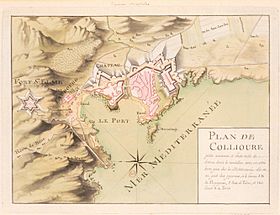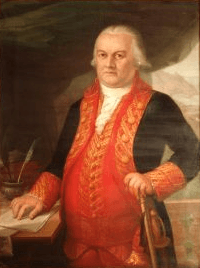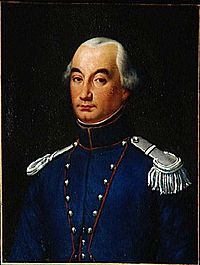Battle of Collioure facts for kids
Quick facts for kids Battle of Collioure |
|||||||
|---|---|---|---|---|---|---|---|
| Part of the War of the Pyrenees | |||||||
 Map of Collioure in the 18th century |
|||||||
|
|||||||
| Belligerents | |||||||
| Commanders and leaders | |||||||
| Units involved | |||||||
| Army of Catalonia | Army of the Eastern Pyrenees | ||||||
| Strength | |||||||
| 8,000 | 5,000 | ||||||
| Casualties and losses | |||||||
| 300 | 4,000, 100 guns | ||||||
The Battle of Collioure took place from December 20 to 23, 1793. It was a major fight during the War of the Pyrenees, which was part of the larger French Revolutionary Wars. In this battle, Spanish soldiers attacked a French army division.
The Spanish troops were led by Gregorio García de la Cuesta. They managed to completely push the French forces out of Collioure, Fort Saint-Elme, and Port-Vendres. The Spanish army was called the Army of Catalonia, led by Antonio Ricardos. The French army was the Army of the Eastern Pyrenees, commanded by François Amédée Doppet and Eustache Charles d'Aoust.
Earlier in September 1793, the French had successfully defended Perpignan from a Spanish attack. However, December brought a series of defeats for the French. A French political leader, Claude Dominique Côme Fabre, was killed during the fighting at Collioure. After this big loss, the French commanders Aoust and Delattre faced severe consequences for the disaster.
Why the Battle Happened
In 1793, the French Army of the Eastern Pyrenees faced many challenges. Political leaders, known as "representatives on mission," had a lot of power. They often interfered with the army's generals. This made it hard for the military leaders to do their job.
For example, one political leader, Claude Dominique Côme Fabre, thought commanders were useless. Another, Raymond Gaston, said he alone should command. This caused a lot of confusion and problems for the army.
Several French commanders were replaced quickly. Louis-Charles de Flers was commander for a few months. He was removed from command and later died. Hilarion Paul Puget de Barbantane took over next. He left his army and resigned after being scared by the Spanish commander Antonio Ricardos.
Despite these problems, the French army won the Battle of Peyrestortes in September. This victory happened thanks to Generals Eustache Charles d'Aoust and Jacques Gilles Henri Goguet.
After another battle, the Battle of Truillas, the Spanish retreated. François Amédée Doppet became the French army commander in late November. He found the army in a terrible state. The soldiers lacked proper equipment, and their horses were starving. The political leaders often gave orders without telling Doppet.
In December, the Spanish planned to attack Villelongue-dels-Monts. Doppet tried to warn the French soldiers there. But the defenders ignored him and attacked the Spanish themselves. This led to a big defeat for the French. The Spanish captured Villelongue.
To get his army to safety for winter, Doppet planned an attack on Villelongue. The political leaders chose Aoust to lead this attack. It happened on December 18 and was a success. French generals like Jean Lannes and Jean Joseph Guieu were involved. They caused heavy losses for the Portuguese soldiers defending the town. They also captured 15 cannons.
On December 20, Doppet became very ill. Many soldiers also got sick. Aoust took over as commander again.
The Battle of Collioure
After his success in early December, Spanish commander Ricardos wanted to push the French out of the coastal towns. These towns included Collioure and Port-Vendres. He sent a Spanish division to attack the French near the Col de Banyuls (Banyuls Pass).
On December 14, the Spanish attacked in several groups. They crossed the Pyrenees mountains through different passes. The attack worked well. The French soldiers had to leave their positions. The Spanish captured 300 French soldiers and 20 cannons. This forced the French division into a small area along the coast.
A few days later, Gregorio García de la Cuesta took command of the Spanish forces. He saw that Collioure could be attacked from three narrow paths through rough land.
The French commander Delattre placed his men on a ridge. This ridge protected both Collioure and Port-Vendres. Cuesta organized his Spanish troops into attacking groups. They broke through the French defenses. The French soldiers ran towards their forts along the coast.
As the French retreated, both Fort Saint-Elme and Port-Vendres closed their gates. They refused to let the fleeing soldiers in. Fort Saint-Elme even fired at them! Feeling betrayed, many French soldiers surrendered to the Spanish.
The commander of Fort Saint-Elme quickly surrendered the fort when the Spanish demanded it. Port-Vendres also gave up. The remaining French troops either went into Collioure or tried to fight their way north. Delattre managed to escape. However, the French political leader Fabre was killed during the fighting.
Cuesta sent three Spanish battalions to approach Collioure at night. They carried torches and threatened to burn the town. Collioure also surrendered. The exact date of the battle's end is a bit unclear. Some sources say December 20, others December 21, and some say Collioure surrendered on December 23.
After the Battle
The French suffered huge losses. Out of 5,000 soldiers, about 4,000 were killed, wounded, or captured. The Spanish also captured 100 cannons from the French army and coastal forts. Cuesta's Spanish force of 8,000 men had only about 300 casualties.
When Aoust heard about the collapse of his army's left side, he ordered a retreat. This happened on December 21, and they headed towards Perpignan. The Spanish Army of Catalonia chased them. Ricardos sent his cavalry to try and surround the French.
In this difficult situation, a French brigade led by Catherine-Dominique de Pérignon blocked the Portuguese forces. This made Ricardos hesitate. This pause allowed the French to escape to safety. Even so, the French lost 7,700 men and 23 cannons before they reached a safe position. They found safety at Perpignan and its strong Camp de l'Union. Only about 8,000 soldiers were left in the French army.
At the end of 1793, other French armies had been successful. Because of this, the French government criticized the Army of the Eastern Pyrenees for its defeat. Aoust, who had become commander just as the disaster happened, was removed from his position. Delattre also faced severe consequences.
January 1794 brought big changes. A new French commander, Jacques François Dugommier, arrived with 10,500 fresh troops. He had just won the Siege of Toulon.
The Spanish commander Ricardos died on March 13, 1794. His replacement, Alejandro O'Reilly, died ten days later. Finally, Luis Firmín de Carvajal, Conde de la Unión became the new leader of the Spanish Army of Catalonia.
Images for kids




